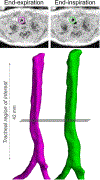Modern pulmonary imaging of bronchopulmonary dysplasia
- PMID: 33547408
- PMCID: PMC8561744
- DOI: 10.1038/s41372-021-00929-7
Modern pulmonary imaging of bronchopulmonary dysplasia
Abstract
Bronchopulmonary dysplasia (BPD) is a complex and serious cardiopulmonary morbidity in infants who are born preterm. Despite advances in clinical care, BPD remains a significant source of morbidity and mortality, due in large part to the increased survival of extremely preterm infants. There are few strong early prognostic indicators of BPD or its later outcomes, and evidence for the usage and timing of various interventions is minimal. As a result, clinical management is often imprecise. In this review, we highlight cutting-edge methods and findings from recent pulmonary imaging research that have high translational value. Further, we discuss the potential role that various radiological modalities may play in early risk stratification for development of BPD and in guiding treatment strategies of BPD when employed in varying severities and time-points throughout the neonatal disease course.
Conflict of interest statement
CONFLICTS OF INTEREST
None
Figures






References
-
- Prayle A, Rosenow T. Looking under the bonnet of bronchopulmonary dysplasia with MRI. Thorax. 2020. February;75(2):100. - PubMed
-
- Raju TNK, Buist AS, Blaisdell CJ, Moxey-Mims M, Saigal S. Adults born preterm: a review of general health and system-specific outcomes. Acta Paediatr. 2017. September;106(9):1409–37. - PubMed
-
- Jobe AH, Bancalari E. Bronchopulmonary dysplasia. Vol. 163, American journal of respiratory and critical care medicine. United States; 2001. p. 1723–9. - PubMed
-
- Jensen EA, Wright CJ. Bronchopulmonary Dysplasia: The Ongoing Search for One Definition to Rule Them All. Vol. 197, The Journal of pediatrics. United States; 2018. p. 8–10. - PubMed
Publication types
MeSH terms
Grants and funding
LinkOut - more resources
Full Text Sources
Other Literature Sources
Medical
Research Materials

